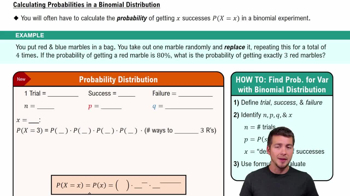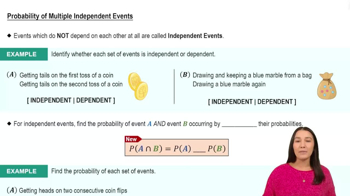Independent Events Again assume that when randomly selecting a speaking character in a movie, the probability of getting a female is 0.331, as in Exercise 1. If we want to find the probability of 20 females when 50 different speaking characters are randomly selected from a population of 1500 speaking characters, are the 50 selections independent? Using the 5% guideline for cumbersome calculations, can they be treated as being independent?
Table of contents
- 1. Intro to Stats and Collecting Data1h 14m
- 2. Describing Data with Tables and Graphs1h 55m
- 3. Describing Data Numerically2h 5m
- 4. Probability2h 16m
- 5. Binomial Distribution & Discrete Random Variables3h 6m
- 6. Normal Distribution and Continuous Random Variables2h 11m
- 7. Sampling Distributions & Confidence Intervals: Mean3h 23m
- Sampling Distribution of the Sample Mean and Central Limit Theorem19m
- Distribution of Sample Mean - Excel23m
- Introduction to Confidence Intervals15m
- Confidence Intervals for Population Mean1h 18m
- Determining the Minimum Sample Size Required12m
- Finding Probabilities and T Critical Values - Excel28m
- Confidence Intervals for Population Means - Excel25m
- 8. Sampling Distributions & Confidence Intervals: Proportion1h 12m
- 9. Hypothesis Testing for One Sample3h 29m
- 10. Hypothesis Testing for Two Samples4h 50m
- Two Proportions1h 13m
- Two Proportions Hypothesis Test - Excel28m
- Two Means - Unknown, Unequal Variance1h 3m
- Two Means - Unknown Variances Hypothesis Test - Excel12m
- Two Means - Unknown, Equal Variance15m
- Two Means - Unknown, Equal Variances Hypothesis Test - Excel9m
- Two Means - Known Variance12m
- Two Means - Sigma Known Hypothesis Test - Excel21m
- Two Means - Matched Pairs (Dependent Samples)42m
- Matched Pairs Hypothesis Test - Excel12m
- 11. Correlation1h 6m
- 12. Regression1h 50m
- 13. Chi-Square Tests & Goodness of Fit1h 57m
- 14. ANOVA1h 57m
5. Binomial Distribution & Discrete Random Variables
Binomial Distribution
Problem 5.2.13a
Textbook Question
Binomial Probability Formula. In Exercises 13 and 14, answer the questions designed to help understand the rationale for the binomial probability formula.
Guessing Answers Standard tests, such as the SAT, ACT, or Medical College Admission Test (MCAT), typically use multiple choice questions, each with five possible answers (a, b, c, d, e), one of which is correct. Assume that you guess the answers to the first three questions.
a. Use the multiplication rule to find the probability that the first two guesses are wrong and the third is correct. That is, find P(WWC), where W denotes a wrong answer and C denotes a correct answer.
 Verified step by step guidance
Verified step by step guidance1
Step 1: Understand the problem. We are tasked with finding the probability of guessing wrong on the first two questions and guessing correctly on the third question. This is represented as P(WWC), where W denotes a wrong answer and C denotes a correct answer.
Step 2: Recall the multiplication rule for independent events. The probability of multiple independent events occurring together is the product of their individual probabilities. In this case, the events are guessing wrong on the first question, guessing wrong on the second question, and guessing correctly on the third question.
Step 3: Determine the probability of each event. Since there are 5 possible answers for each question and only 1 correct answer, the probability of guessing wrong (W) is 4/5, and the probability of guessing correctly (C) is 1/5.
Step 4: Apply the multiplication rule. Multiply the probabilities of the three events: P(WWC) = P(W) × P(W) × P(C). Substitute the probabilities: P(WWC) = (4/5) × (4/5) × (1/5).
Step 5: Simplify the expression. Multiply the fractions to find the final probability. The result will represent the probability of guessing wrong on the first two questions and correctly on the third question.
 Verified video answer for a similar problem:
Verified video answer for a similar problem:This video solution was recommended by our tutors as helpful for the problem above
Video duration:
2mPlay a video:
Was this helpful?
Key Concepts
Here are the essential concepts you must grasp in order to answer the question correctly.
Binomial Probability
The binomial probability formula calculates the likelihood of obtaining a fixed number of successes in a fixed number of independent Bernoulli trials, each with the same probability of success. In this context, a 'success' could be guessing the correct answer, while a 'failure' would be guessing incorrectly. The formula is given by P(X = k) = (n choose k) * p^k * (1-p)^(n-k), where n is the number of trials, k is the number of successes, and p is the probability of success.
Recommended video:
Guided course

Calculating Probabilities in a Binomial Distribution
Multiplication Rule
The multiplication rule in probability states that the probability of two independent events occurring together is the product of their individual probabilities. For example, if the probability of guessing incorrectly on the first question is 4/5 and the probability of guessing correctly on the third question is 1/5, the overall probability of the sequence of events (WWC) can be calculated by multiplying these probabilities together.
Recommended video:

Probability of Multiple Independent Events
Independent Events
Independent events are those whose outcomes do not affect each other. In the context of guessing answers on a multiple-choice test, each guess is independent because the outcome of one guess does not influence the others. This independence allows us to apply the multiplication rule to find the probability of a specific sequence of correct and incorrect answers.
Recommended video:

Probability of Multiple Independent Events

 6:00m
6:00mWatch next
Master The Binomial Experiment with a bite sized video explanation from Patrick
Start learningRelated Videos
Related Practice
Textbook Question
